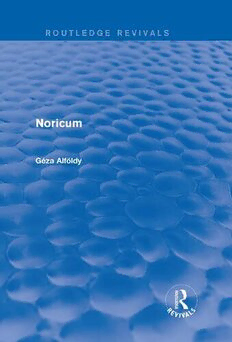
Noricum (1974) PDF
Preview Noricum (1974)
Routledge Revivals Noricum The Roman province of Noricum occupied most of Austria as well as parts of Italy, Germany and the Balkans. Noricum, first published in 1974, presents a comprehensive history of the province, from 400 BC to the end of Roman rule in AD 600. Professor Alföldy’s account is predicated on the methodical interpretation of literary, epigraphic and archaeological sources, and emphasises the problems of demography and socio-economic history. The chapters are arranged chronologically, ensuring a sense of the continuity of historical events and illuminating the history and archaeology of Noricum both before it came into contact with the Romans as well as under Roman rule. Noricum includes a review of much recent research on the province, detailed references to the source material, a comprehensive bibliography and valuable appendices. It is a substantial work of ancient history and archaeology and will interest both the specialist and the general reader. This page intentionally left blank Noricum Géza Alföldy Firstpublishedin1974 byRoutledge&KeganPaulLtd Thiseditionfirstpublishedin2014byRoutledge 2ParkSquare,MiltonPark,Abingdon,Oxon,OX144RN andbyRoutledge 711ThirdAvenue,NewYork,NY10017 RoutledgeisanimprintoftheTaylor&FrancisGroup,aninformabusiness ©1974GézaAlföldy The right of Géza Alföldy to be identified as author of this work has been asserted by him in accordancewithsections77and78oftheCopyright,DesignsandPatentsAct1988. Allrightsreserved.Nopartofthisbookmaybereprintedorreproducedorutilisedinanyformorby anyelectronic,mechanical,orothermeans,nowknownorhereafterinvented,includingphotocopying andrecording,orinanyinformationstorageorretrievalsystem,withoutpermissioninwritingfrom thepublishers. Publisher’sNote Thepublisherhasgonetogreatlengthstoensurethequalityofthisreprintbutpointsoutthatsome imperfectionsintheoriginalcopiesmaybeapparent. Disclaimer The publisher has made every effort to trace copyright holders and welcomes correspondence from thosetheyhavebeenunabletocontact. ALibraryofCongressrecordexistsunderLCcontrolnumber:74176996 ISBN13:978-1-138-01814-3(hbk) ISBN13:978-1-315-77992-8(ebk) Noricum Geza Alföldy Professor of Ancient History Ruhr-Universität Bochum Translated by Anthony Birley LONDON AND BOSTON ROUTLEDGE & KEGAN PAUL First published il1 I9 7 4 by Routledge & Kegan Paul Ltd Broadway House, 63-74 Carter Lane London EC4 V JEL and 9 Park Street, Boston, Mass. 02I03, U.S.A. Printcd in Great Britain by Richard Clay (Th e Chaucer Press) Ltd Bungqy, Suffolk © Geza Aljöldy I974 oJ No part this book mqy be reprodttced in any form without permission from the publisher, except for the quotation of brief passages in criticism ISBN 0 7IOO 7}2} 0 Contents Preface xvii Chronological table xxi Chapter Research, sources and geography I I Modern research and the ancient sources 1 Noricum in ancient geographical works 7 The physical geography of the country 9 Roads and communications 11 Chapter 2 Veneti, Illyrians and Celts 14 The problem of the pre-Roman population 14 Veneti and Illyrians 17 Celts 21 T aurisci and N orici 25 Chapter 3 The rise of the regntlm Noricutll 28 Rome and the east Alpine lands 28 The early regnum Noricum 31 The Cimbric invasion and Noricum 35 Chapter 4 The regnum Noricum in the first century B.C. 39 Noricum and the Boii 39 The state, society and economy 42 The republican settlement on the Magdalensberg 44 The Noreia question 47 vii Contents Chapter J The Roman annexation 52 The occupation ofNoricum 52 The establishment of the province's borders 57 Chapter 6 Noricum under Augustus and Tiberius 62 The administration and the army 62 The civitates 66 The golden age of the Magdalensberg 7° Population and society 74 Chapter 7 The reforms of Claudius and their consequences 78 Provincial administration 78 Urbanisation and citizenship 81 The building of the towns 87 Territoria and the local government of the towns 96 Roads, limes and army 1°3 Chapter 3 Town and country under the Flavians and Antonines I06 Farming I06 Industry I08 Trade III Mining II3 The running of the economy II4 The upper classes II7 The lower classes and slavery 127 Romanisation 132 Chapter 9 The Norican frontier and the Marcomannic Wars 143 Army and fron tier under the Flavians and Antonines 143 Noricum and the Marcomannic Wars 152 Chapter IO From the Marcomannic Wars to Diocletian 159 The administration 159 Limes, army and warfare 165 Agriculture, mining, industry and trade 171 The financial crisis and the fate of the towns 178 The transformation of society 187 Spiritual and intellectual changes 193 vüi Contents Chapter I I From Diocletian to Honorius 198 The administration 199 The Norican limes from Diocletian to Honorius 201 Town and country 205 The spread of Christianity 208 Chapter 12 The decline of Roman rule 213 N orieum in the fifth eentury and the work of St Severinus 21 3 The abandonment of Noricum Ripense and the fate of the ~~rior 2~ Appendices I 'Venetie' personal names in Noricum 229 II 'Illyrian' personal names in Norieum 230 III Celtic personal names in Norieum 232 IV Celtie names of deities in Norieum 239 V The presidial proeurators of Noricum 242 VI Senatorial governors of Noricum 248 VII Agentes vices praesidis in Norieum 251 VIII Beneftciarii posts in Noricum 252 IX Offices of the Illyrian eustoms-zone (portorium publicum Illyrici) in Noricum 254 X The auxiliary units in Noricum 257 XI Noricans in the Roman army 261 XII Distribution of imperial gentilicia among the native population of Noricum 262 XIII Town officials, eouncillors and collegia 264 XIV Equites Romani from Noricum 274 XV Senators from Noricum 277 XVI Dated milestones in Norieum 278 XVII Evidenee for Christianity in Noricum (individual sites) 279 Notes 283 Abbreviations of periodicals and works of referenee 349 Seleet Bibliography 352 Indexes 383 General Map of Noricum Plates ix
